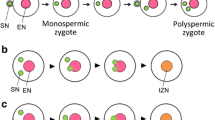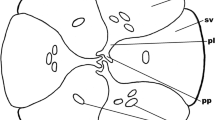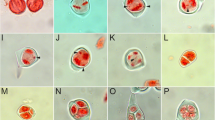Summary
Megasporogenesis and megagametogenesis in diploid tuber-bearing Solanum species hybrids were studied and illustrated in detail. Megagametogenesis followed the normal or Polygonum type of embryo sac development. In megasporogenesis a few regularly occurring deviations from what is usually considered to be the normal course of megasporogenesis were detected.
Firstly, the development of a surplus of adjacent or non-adjacent megaspore mother cells in a single ovule was frequently observed. As they eventually may give rise to normally reduced, sexual embryo sacs, it is concluded that the archesporium in potato cannot be delimited to a single cell or even a group of adjacent cells in the ovule. Secondly, the micropylar daughter cell which is formed after completion of the first division was often found to degenerate before the onset or completion of the second division giving rise to a triad instead of a tetrad of megaspores. The spatial arrangement of megaspores within the ovule was found to vary according to the variation in the relative orientation of second division spindles.
It is concluded that these deviations should be considered random legitimate variations of megasporogenesis rather than systematic abnormal events.
The implications of the overall pattern of megasporogenesis for the formation of 2n-eggs and the attempts to induce diplosporic or aposporic apomixis in potato are discussed.
Similar content being viewed by others
References
Arnason, T. J., 1948. Female sterility in potatoes. Can. J. Bot. 21: 41–56.
Berlyn, G. P. & J. P. Miksche, 1976. Botanical microtechnique and cytochemistry. The Iowa State University Press, Ames, Iowa, 326 pp.
Bhaduri, P. N., 1932. The development of ovule and embryo sac in Solanum meolongena. J. Ind. Bot. Soc. 11: 202–224.
Gerlach, D., 1977. Botanische Mikrotechnik. Georg Thieme Verlag, Stuttgart, 2nd edition, 311 pp.
Gohil, R. H. & R. Kaul, 1981. Studies on male and female meiosis in Indian Allium. II. Autotetraploid Allium tuberosum. Chromosoma 82: 735–739.
Gustafsson, A., 1935. Studies on the mechanism of parthenogenesis. Hereditas 21: 1–111.
Gustafsson, A., 1946. Apomixis in higher plants. I. The mechanisms of apomixis. Lunds Univ. Arsskr. 42: 1–66.
Hakansson, A. & A. Levan, 1957. Endo duplicational meiosis in Allium odorum. Hereditas 43: 179–200.
Hermsen, J. G. Th., 1977. Towards the cultivation in developing countries of hybrid populations of potato from botanical seeds. In: Report Planning Conference on the utilization of genetic resources of the potato, 1977. CIP, Lima, Peru, 101–109.
Hermsen, J. G. Th., 1980. Breeding for apomixis in potato: pursuing a utopian scheme? Euphytica 29: 595–607.
Hermsen, J. G. Th., 1984a. Mechanisms and genetic implications of 2n-gamete formation. Iowa State J. Res. 58: 421–434.
Hermsen, J. G. Th., 1984b. The potential of meiotic polyploidization in breeding allogamous crops. Iowa State J. Res. 58: 435–448.
Hermsen, J. G. Th., 1984c. Haploids as a tool in breeding polyploids. Iowa State J. Res. 58: 449–460.
Hermsen, J. G. Th., M. S. Ramanna & E. Jongedijk, 1985. Apomictic approach to introduce uniformity and vigour into progenies from true potato seed (TPS). In: Report 26 Planning Conference ‘Present and future strategies for potato breeding and improvement’, 1983, CIP, Lima, Peru, 99–114.
Iwanaga, M. & S. J. Peloquin, 1979. Synaptic mutant affecting only megasporogenesis in potatoes. J. Heredity 70: 385–389.
Iwanaga, M., 1980. Diplogynoid formation in diploid potatoes. Ph. D. Thesis, University of Wisconsin, Madison, 113 pp.
Iwanaga, M., 1982. Chemical induction of aposporous apomictic seed production. In: Proceedings International Congress ‘Research for the potato in the year 2000’. CIP, Lima, Peru, 104–105.
Jacobsen, E., 1978. Die Chromosomen Verdopplung in der Züchtung dihaploider Kartoffeln. Ph. D. Thesis Rheinischen Friedrich Wilhelm Universität, Bonn, 159 pp.
Jongedijk, E., 1983. Selection for first division restitution 2n-egg formation in diploid potatoes. Potato Res. 26: 399 (Abstract).
Lamm, R., 1937. A contribution to the embryology of the potato. Svensk Bot. Tidskr. 31: 217–220.
Lesley, M. M., 1926. Maturation in diploid and triploid tomatoes. Genetics 11: 267–279.
Mendiburu, A. O., S. J. Peloquin & D. W. S. Mok, 1974. Protato breeding with haploids and 2n gametes. In: K. Kasha (Ed.), Haploids in higher plants. University of Guelph, Guelph, Canada, 249–258.
Mendiburu, A. O. & S. J. Peloquin, 1977. The significance of 2n gametes in potato breeding. Theor. Appl. Genet. 49: 53–61.
Mok, D. W. S. & S. J. Peloquin, 1975. Three mechanisms of 2n pollen formation in diploid potatoes. Can. J. Genet. Cytol. 17: 217–225.
Peloouin, S. J., 1981. Chromosomal and cytoplasmic manipulations. In: K. J. Frey (Ed.). Plant Breeding II. The Iowa State University Press. Ames, Iowa, 117–150.
Peloquin, S. J., 1982. Meiotic mutants in potato breeding. Stadler Genetics Symposia 14: 1–11.
Peloquin, S. J., 1983a. ‘New approaches to breeding for the potato of the year 2000’. In: Proceedings International Congress ‘Research for the potato in the year 2000’. CIP, Lima, Peru, 32–34.
Peloquin, S. J., 1983b. Genetic engineering with meiotic mutants. In: D. L. Mulcahy & E. Ottaviano (Eds). Pollen: biology and implications for plant breeding. Elsevier Science Publishing Co., Inc., 311–316.
Pfeiffer, T. W. & E. T. Bingham, 1983. Abnormal meiosis in alfalfa, Medicago sativa: cytology of 2n egg and 4n pollen formation. Can. J. Genet. Cytol. 25: 107–112.
Ramanna, M. S., 1979. A re-examination of the mechanisms of 2n gamete formation in potato and its implications for breeding. Euphytica 28: 537–561.
Ramanna, M. S., 1983. First division restitution gametes through fertile desynaptic mutants of potato. Euphytica 32: 337–350.
Rees-Leonard, O. L., 1935. Macrosporogenesis and development of the macrogametophyte of Solanum tuberosum. Botanical Gazette 96: 734–750.
Rutishauser, A. 1967. Fortpflanzungsmodus und Meiose apomiktischer Blütenpflanzen. Protoplasmatologia, Band VI F3. Springer-Verlag, Wien-New York, 245 pp.
Stebbings, G. L.Jr., 1950. Variation and evolution in plants. Columbia University Press, New York, 643 pp.
Walker, R. T., 1955. cytological and embryological studies in Solanum, section Tuberarium. Bull. Torrey Bot. Club 82: 87–101.
Young, W. J., 1922. Potato ovules with two embryo sacs. Amer. J. Bot. 9: 213–214.
Young, W. J., 1923. The formation and degeneration of germ cells in the potato. Amer. J. Bot. 10: 325–335.
Author information
Authors and Affiliations
Rights and permissions
About this article
Cite this article
Jongedijk, E. The pattern of megasporogenesis and megagametogenesis in diploid Solanum species hybrids; its relevance to the origin of 2n-eggs and the induction of apomixis. Euphytica 34, 599–611 (1985). https://doi.org/10.1007/BF00035395
Received:
Issue Date:
DOI: https://doi.org/10.1007/BF00035395




